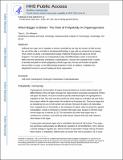| dc.contributor.author | Orr-Weaver, Terry L. | |
| dc.contributor.author | Orr-Weaver, Terry | |
| dc.date.accessioned | 2017-04-07T19:49:25Z | |
| dc.date.available | 2017-04-07T19:49:25Z | |
| dc.date.issued | 2015-04 | |
| dc.identifier.issn | 0168-9525 | |
| dc.identifier.uri | http://hdl.handle.net/1721.1/107974 | |
| dc.description.abstract | Defining how organ size is regulated, a process controlled not only by the number of cells but also by the size of the cells, is a frontier in developmental biology. Large cells are produced by increasing DNA content or ploidy, a developmental strategy employed throughout the plant and animal kingdoms. The widespread use of polyploidy during cell differentiation makes it important to define how this hypertrophy contributes to organogenesis. I discuss here examples from a variety of animals and plants in which polyploidy controls organ size, the size and function of specific tissues within an organ, or the differentiated properties of cells. In addition, I highlight how polyploidy functions in wound healing and tissue regeneration. | en_US |
| dc.description.sponsorship | United States. National Institutes of Health (GM57960) | en_US |
| dc.description.sponsorship | American Cancer Society | en_US |
| dc.language.iso | en_US | |
| dc.publisher | Elsevier | en_US |
| dc.relation.isversionof | http://dx.doi.org/10.1016/j.tig.2015.03.011 | en_US |
| dc.rights | Creative Commons Attribution-NonCommercial-NoDerivs License | en_US |
| dc.rights.uri | http://creativecommons.org/licenses/by-nc-nd/4.0/ | en_US |
| dc.source | Elsevier | en_US |
| dc.title | When bigger is better: the role of polyploidy in organogenesis | en_US |
| dc.type | Article | en_US |
| dc.identifier.citation | Orr-Weaver, Terry L. “When Bigger Is Better: The Role of Polyploidy in Organogenesis.” Trends in Genetics 31, no. 6 (June 2015): 307–315. © 2015 Elsevier Ltd. | en_US |
| dc.contributor.department | Massachusetts Institute of Technology. Department of Biology | en_US |
| dc.contributor.mitauthor | Orr-Weaver, Terry | |
| dc.relation.journal | Trends in Genetics | en_US |
| dc.eprint.version | Author's final manuscript | en_US |
| dc.type.uri | http://purl.org/eprint/type/JournalArticle | en_US |
| eprint.status | http://purl.org/eprint/status/PeerReviewed | en_US |
| dspace.orderedauthors | Orr-Weaver, Terry L. | en_US |
| dspace.embargo.terms | N | en_US |
| dc.identifier.orcid | https://orcid.org/0000-0002-7934-111X | |
| mit.license | PUBLISHER_CC | en_US |
